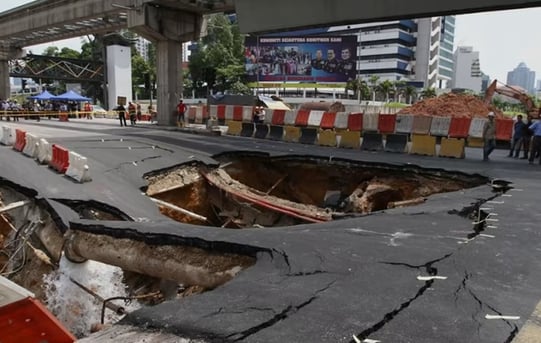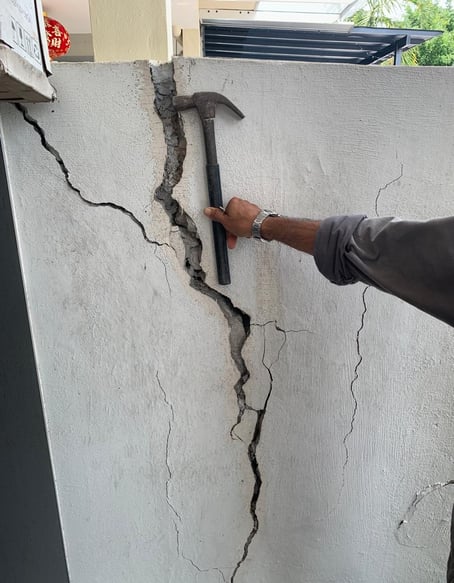Sinkhole Repair Contractors
Sinkholes are becoming more frequent in Malaysia, especially in cities like KL, Penang, and JB, mainly due to damage to underground utilities and soil erosion. This presents a serious concern for both the public and property owners. Predicting when and where they will occur is difficult, particularly for those with homes or buildings in vulnerable areas. Unlike other forms of ground movement, sinkholes are especially troubling because they can appear without warning, often causing severe and irreversible damage.
What Causes Sinkholes and How Do They Develop?
Sinkholes typically form naturally when water slowly erodes bedrock, creating an underground cavity. Over time, loose material closer to the surface begins to collapse into the void, much like sand falling through an hourglass, until the surface can no longer support its own weight.
Eventually, the ground gives way, resulting in a sinkhole. These events are often sudden and can be extremely dangerous. In some cases, sinkholes are triggered by old mine shafts or other deep underground voids. At Re-Level, the team is committed to preventing sinkholes and repairing them when they do occur.


How Do Our Experts Detect Sinkhole Development?
We utilize cutting-edge geophysical methods, such as seismic wave surveys, to carefully evaluate ground stability. By identifying subsurface weaknesses and voids, we can pinpoint areas susceptible to sinkhole formation. This proactive strategy enhances the safety and integrity of your property by addressing potential risks before they develop into serious issues.
What Are the Early Signs of Sinkhole Formation?
Sinkholes are a type of subsidence, where the ground gradually sinks. Like other forms of subsidence, there are often early warning signs before severe damage occurs. If you observe any of the following signs in or around your property, it's important to have an expert, such as Re-Level, inspect the area to determine if a sinkhole may be developing.
Cracks in the walls
Cracks around door frames and windows
Stairstep cracks in brickwork
Widening cracks
Tilting trees or posts
A dip forming in the garden or driveway
A pond suddenly draining away
Uneven floors
Dying vegetation in a concentrated area
Dying vegetation in a concentrated area
Of course, these things may just be signs of less severe subsidence or natural settlement. However, if in doubt, it is best to be on the safe side and get it checked out.
We can visit your property to assess what depths of treatment are needed to return your property to its original state if subsidence or a sinkhole risk is present. Please contact us to arrange a no obligation site visit – we’ll talk to you and work out the best solution for your particular problem.


What Are the Best Ways to Prevent Sinkholes?
Traditionally, cement slurry is used for sinkhole repairs, but its drawback is that it cannot effectively fill all the voids. PU resin, on the other hand, can fill more gaps, making it a superior option compared to conventional methods.
Sinkholes can be prevented by reinforcing the ground before a large void forms and causes the surface to collapse. At Re-Level, we specialize in ground strengthening around properties as a proactive measure. Our method involves injecting polyurethane resin into the affected areas, where it binds with and compacts the soil, significantly enhancing the ground’s ability to support your property. This process not only increases the soil’s capacity to bear weight but, in some cases, the expansive properties of our materials can even lift your property back to its original level.
Sinkhole Prevention: Steps You Can Take
For effective sinkhole prevention, follow these key guidelines:
Watch for warning signs like large cracks, ground shifts, or pooling water after rain.
Call a professional if signs appear for assessment and repair.
Schedule regular inspections for older homes to catch potential issues early.
Install proper drainage systems such as gutters, sump pumps, and catch basins.
Properly seal or abandon underground water sources like springs or wells.
Fill construction excavation areas with stable soil and rocks.
Consider installing a French drain system to redirect excess moisture.
Plant vegetation to absorb rainwater and prevent pooling.
Investigate local geology, like karst topography, to assess sinkhole risk.
Regularly pump septic tanks to avoid groundwater buildup and weakened soil stability.
Repairing Sinkholes After They Occur
Re-Level also offers ground repair services for areas where sinkholes have already formed. We utilize our advanced Polyurethane resin injection method to stabilize the ground and aid in its restoration.
